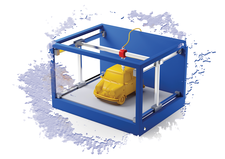Going from a sketch to a printed object
Emergence

How do you get from an idea to a finished printed object? We'll take you through the steps with a glamorous example: a pair of 3D-printed earrings.
Every 3D-printed project begins with an idea. Where does the idea come from? The simplest solution is to use a model that already exists. Several Internet platforms collect finished 3D models, including MyMiniFactory [1], Thingiverse [2], or even a special NASA [3] website. From these sites, you can download finished 3D models for printing, and in some cases, you can even publish your own 3D models for the community.
Another way to create a 3D model is to scan or photograph real-world objects and then use software, such as a photogrammetry application, to generate a model. For instance, you could photograph an object from different perspectives and from all sides; when you have created 50 or more photos, you can then convert the photos into a 3D model using specialized software. See the 3Dnatives site [4] for an overview of possible software tools, including some open source programs.
A third approach is to design a 3D model directly and then print the design. This article demonstrates this approach with a pair of earrings. Their shape was first sketched the old-fashioned way using a pencil and paper (Figure 1). You can see two rectangles pushed into each other. The next step is to transfer this project idea to a 3D model.
[...]
Buy this article as PDF
(incl. VAT)
Buy Linux Magazine
Subscribe to our Linux Newsletters
Find Linux and Open Source Jobs
Subscribe to our ADMIN Newsletters
Support Our Work
Linux Magazine content is made possible with support from readers like you. Please consider contributing when you’ve found an article to be beneficial.

News
-
Parrot OS Switches to KDE Plasma Desktop
Yet another distro is making the move to the KDE Plasma desktop.
-
TUXEDO Announces Gemini 17
TUXEDO Computers has released the fourth generation of its Gemini laptop with plenty of updates.
-
Two New Distros Adopt Enlightenment
MX Moksha and AV Linux 25 join ranks with Bodhi Linux and embrace the Enlightenment desktop.
-
Solus Linux 4.8 Removes Python 2
Solus Linux 4.8 has been released with the latest Linux kernel, updated desktops, and a key removal.
-
Zorin OS 18 Hits over a Million Downloads
If you doubt Linux isn't gaining popularity, you only have to look at Zorin OS's download numbers.
-
TUXEDO Computers Scraps Snapdragon X1E-Based Laptop
Due to issues with a Snapdragon CPU, TUXEDO Computers has cancelled its plans to release a laptop based on this elite hardware.
-
Debian Unleashes Debian Libre Live
Debian Libre Live keeps your machine free of proprietary software.
-
Valve Announces Pending Release of Steam Machine
Shout it to the heavens: Steam Machine, powered by Linux, is set to arrive in 2026.
-
Happy Birthday, ADMIN Magazine!
ADMIN is celebrating its 15th anniversary with issue #90.
-
Another Linux Malware Discovered
Russian hackers use Hyper-V to hide malware within Linux virtual machines.

